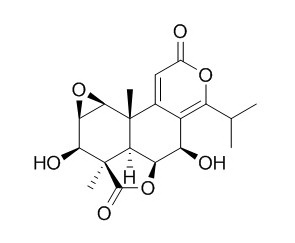Nagilactone C
Nagilactone C and phyllanthoside are novel protein synthesis inhibitors, they are specific for the eukaryotic translation apparatus, function in vivo and in vitro, and interfere with translation elongation. Nagilactone C shows high insecticidal activity against second-instar nymphs of Eocanthecona furcellata. Nagilactone C possesses potent antiproliferative activity against human fibrosarcoma and murine colon carcinoma tumor cell lines exhibiting ED50 values of 2.3 and 1.2 microg/ml, respectively.
Inquire / Order:
manager@chemfaces.com
Technical Inquiries:
service@chemfaces.com
Tel:
+86-27-84237783
Fax:
+86-27-84254680
Address:
1 Building, No. 83, CheCheng Rd., Wuhan Economic and Technological Development Zone, Wuhan, Hubei 430056, PRC
Providing storage is as stated on the product vial and the vial is kept tightly sealed, the product can be stored for up to
24 months(2-8C).
Wherever possible, you should prepare and use solutions on the same day. However, if you need to make up stock solutions in advance, we recommend that you store the solution as aliquots in tightly sealed vials at -20C. Generally, these will be useable for up to two weeks. Before use, and prior to opening the vial we recommend that you allow your product to equilibrate to room temperature for at least 1 hour.
Need more advice on solubility, usage and handling? Please email to: service@chemfaces.com
The packaging of the product may have turned upside down during transportation, resulting in the natural compounds adhering to the neck or cap of the vial. take the vial out of its packaging and gently shake to let the compounds fall to the bottom of the vial. for liquid products, centrifuge at 200-500 RPM to gather the liquid at the bottom of the vial. try to avoid loss or contamination during handling.
Chem Biol Interact.2018, 283:59-74
Plos One.2020, 10.1371
BMC Complement Altern Med.2016, 16:213
Microb Pathog.2024, 189:106609.
Life Sci.2018, 209:498-506
Anat Rec (Hoboken).2021, 304(2):323-332.
Sci Rep.2023, 13(1):13610.
Preprints2022, 2022030063.
Antioxidants (Basel).2021, 10(11): 1802.
Anticancer Res.2014, 34(7):3505-9
Related and Featured Products
Phytomedicine. 2001 Nov;8(6):489-91.
An antiproliferative norditerpene dilactone, Nagilactone C, from Podocarpus neriifolius.[Pubmed:
11824527]
METHODS AND RESULTS:
An ethanolic extract of Podocarpus neriifolius D. Don (Podocarpaceae) showed antiproliferative activity against two major tumor cell lines, viz. human HT-1080 fibrosarcoma and murine color 26-L5 carcinoma. Bioassay guided fractionation showed the highest antiproliferative activity in chloroform-soluble fraction. Nagilactone C, the major constituent of this fraction was isolated and characterized by using NMR, IR and FAB-MS spectroscopic methods.
CONCLUSIONS:
Nagilactone C possessed potent antiproliferative activity against human fibrosarcoma and murine colon carcinoma tumor cell lines exhibiting ED50 values of 2.3 and 1.2 microg/ml, respectively. Hence, Nagilactone C could be the active constituent present in this plant.
J Chem Ecol. 2001 Jul;27(7):1345-53.
Sequestration of host plant-derived compounds by geometrid moth, Milionia basalis, toxic to a predatory stink bug, Eocanthecona furcellata.[Pubmed:
11504032]
A predatory stink bug, Eocanthecona furcellata, died after feeding on Milionia basalis larvae.
METHODS AND RESULTS:
The compounds toxic to E. furcellata were isolated from the hemolymph of M. basalis larvae and identified as inumakilactone A, Nagilactone C, and Nagilactone C glucoside. The concentrations of inumakilactone A, Nagilactone C, and Nagilactone C glucoside in the hemolymph of the final instar larvae were 130, 50, and 770 microg/ml, respectively. Nagilactone C showed the highest insecticidal activity against second-instar nymphs of E. furcellata, while Nagilactone C glucoside showed the lowest, one twentieth of that of Nagilactone C. When mixed compounds were given at the same concentrations as those in hemolymph of M. basalis, all nymphs of E. furcellata died with in three days. Inumakilactone A and Nagilactone C were found to be in the leaves of podocarp, Podocarpus macrophyllus, the only host plant of M. basalis, at concentrations of 13 and 175 microg/g fresh weight, respectively. However, no Nagilactone C glucoside was detected in the leaves of this species.
CONCLUSIONS:
These results suggested that M. basalis may transform Nagilactone C to its glucoside.
Chem Pharm Bull (Tokyo). 2008 Apr;56(4):585-8.
Cytotoxic constituents from Podocarpus fasciculus.[Pubmed:
18379113]
METHODS AND RESULTS:
A new diterpene, 16-hydroxy communic acid (1), along with thirty one known compounds including five norditerpenes (2-6), twenty two flavonoids containing four biflavonoids (7-10), nine monoflavonoids (11-19) and nine flavanoid glycosides (20-28), as well as four phenolic constituents (29-32) were isolated from the 95% ethanolic extract of Podocarpus fasciculus. The structure of 1 was elucidated using spectral methods.
CONCLUSIONS:
Of these isolates, Nagilactone C (2) showed the most significant inhibitory effects against DLD cells (human colon carcinoma) (ED(50)=2.57 microg/ml) and compounds 7, 8, 10, 11, and 12 had moderate cytotoxic activity against human KB (human oral epithelium carcinoma), Hela (human cervical carcinoma), Hepa (human hepatoma), DLD (colon carcinoma), and A-549 (human lung carcinoma) tumor cell lines.Preliminary structure-activity relationship studies of the isolated diterpenoids and biflavonoids are discussed.
RNA. 2004 Mar;10(3):528-43.
Eukaryotic protein synthesis inhibitors identified by comparison of cytotoxicity profiles.[Pubmed:
14970397 ]
The National Cancer Institute (NCI) Human Tumor Cell Line Anti-Cancer Drug Screen has evaluated the cytotoxicity profiles of a large number of synthetic compounds, natural products, and plant extracts on 60 different cell lines.
METHODS AND RESULTS:
The data for each compound/extract can be assessed for similarity of cytotoxicity pattern, relative to a given test compound, using an algorithm called COMPARE. In applying a chemical biology approach to better understand the mechanism of eukaryotic protein synthesis, we used these resources to search for novel inhibitors of translation. The cytotoxicity profiles of 31 known protein synthesis inhibitors were used to identify compounds from the NCI database with similar activity profiles. Using this approach, two natural products, phyllanthoside and Nagilactone C, were identified and characterized as novel protein synthesis inhibitors. Both compounds are specific for the eukaryotic translation apparatus, function in vivo and in vitro, and interfere with translation elongation.
CONCLUSIONS:
Our results demonstrate the feasibility of utilizing cytotoxicity profiles to identify new inhibitors of translation.



